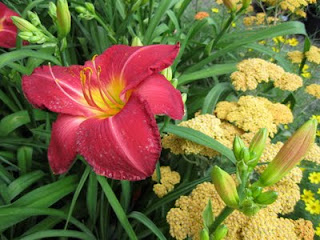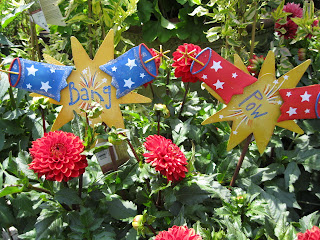 |
| 'Bela Lugosi' daylily |
Coneflowers may come close, but I’m always thrilled when the first daylily breaks into bloom. That’s when I know summer is in full swing. Time to break out the lemonade and barbeque sauce.
The botanic name of daylilies, hemerocallis, comes from the Greek words for day (hemera) and beautiful (kalos) as each flower lasts only one day. They generally bloom from sunrise to sunset, which makes their beauty even more precious.
 |
| 'Lavender Deal' daylily |
There are literally thousands of colors and shapes to choose from: the traditional or diploid ones, tetraploids with thicker petals and larger blooms, doubles, triples, spiders, those with ruffled edges or “diamond dust,” even some with fragrance.
That’s a far cry from the orange daylilies (hemerocallis fulva) that grew in my backyard when I was a kid. My father mowed over them not once but twice, claiming they were a "weed.” Of course, they bounced back better than ever.
Ironically, many states now agree with my dad’s assessment. These lilies -- also called tiger lilies, ditch lilies, roadside lilies and even outhouse lilies -- are considered an invasive weed in several states including Wisconsin. They spread by rhizomes, or underground roots, and are almost impossible to get rid of once they’re planted. While that’s good if you have a problem spot in your yard, it can be a problem if you ever change your mind. You need to remove every little bit of root, and I mean EVERY bit.
 |
| 'Spiritual Corridor' daylily |
The newer varieties, for better or for worse, aren’t quite so vigorous. They need the same care as any new perennial, at least for the first year. You can’t just plant and forget about them like the fulva daylilies. One of my husband’s college friends unfortunately learned that in a big way one year when all of his new daylilies died.
And modern daylilies aren’t exactly low maintenance. They eventually will shade out most weeds that try to grow underneath them, but you need to break off the spent blooms, or deadhead, for them to look their best. That’s especially true with the larger, darker blossoms. The old blooms will eventually fall off, but they make the plant look messy until then.
 |
| 'Wayside King Royale' daylilies |
Daylilies started getting fancier in the 1920’s and 1930’s and have been going strong ever since. I currently have mostly purple daylilies in my garden. There’s Lavender Deal, Wayside King Royale, Bela Lugosi, Fuschia Dream, Chicago Arnie’s Choice, Prairie Blue Eyes, Swirling Waters and Little Grapette.
Other daylilies that I’ve grown include Catherine Woodbury, Lilting Lavender, Cherry Cheeks and Joan Senior.
 |
| 'Charles Johnston' daylily |
My wish list includes Charles Johnston, a great-looking red flower, and one of the late-blooming varieties such as Autumn Minaret. I saw the latter planted in some containers in Minneapolis one fall and it was spectacular at more than 5-foot tall.
What are some of your favorites?
By Karen Geisler


